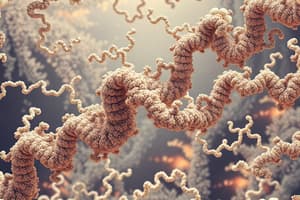Podcast
Questions and Answers
How many standard amino acids are found in proteins across all species of life?
How many standard amino acids are found in proteins across all species of life?
- 30
- 20 (correct)
- 15
- 25
Which type of amino acids are valine, methionine, and alanine classified as?
Which type of amino acids are valine, methionine, and alanine classified as?
- Polar
- Hydrophilic
- Basic
- Nonpolar or hydrophobic (correct)
What is the basic structure of an amino acid?
What is the basic structure of an amino acid?
- Carbon, hydrogen, nitrogen, and oxygen molecules
- Carbon, oxygen, hydrogen, and sulfur molecules
- Carbon, nitrogen, oxygen, and sulfur atoms
- Carbon, hydrogen, oxygen, and nitrogen atoms (correct)
What part of an amino acid determines the nature of the amino acid?
What part of an amino acid determines the nature of the amino acid?
What is the charge of the side chains of lysine and arginine?
What is the charge of the side chains of lysine and arginine?
What is the process by which amino acids form peptide bonds during protein synthesis?
What is the process by which amino acids form peptide bonds during protein synthesis?
What function do amino acids serve in biological processes?
What function do amino acids serve in biological processes?
Which of the following is an example of a structural protein?
Which of the following is an example of a structural protein?
What is the primary function of contractile proteins like actin and myosin?
What is the primary function of contractile proteins like actin and myosin?
What is the relationship between the sequence of amino acids and the final structure and function of a protein?
What is the relationship between the sequence of amino acids and the final structure and function of a protein?
Study Notes
Proteins and Their Building Blocks: Amino Acids
Introduction
Proteins are complex macromolecules responsible for performing a variety of vital functions within cells. They carry out numerous tasks such as providing structural support, serving as enzymes, acting as messengers, and facilitating transportation processes. Amino acids are the foundation upon which proteins are constructed. These organic compounds serve as the building blocks for peptides and proteins, playing crucial roles in biological processes like growth, the digestion of food, tissue repair, and more.
Amino Acid Structure
An amino acid's basic structure comprises a central carbon atom bonded to an amino group (a nitrogen atom with two hydrogen atoms attached, symbolized as NH2), a carboxyl group (a carbon atom bonded to two oxygen atoms and a hydrogen atom, symbolized as COOH), a hydrogen atom, and a variable R group, which determines the nature of the amino acid. The name "amino acid" comes from the combination of these functional groups.
There are twenty standard amino acids found in proteins across all species of life. Each amino acid has a slightly different R group, which influences the type of compound it is, such as acidic, basic, polar, or nonpolar. For instance, amino acids like valine, methionine, and alanine are nonpolar or hydrophobic, while others like serine, threonine, and cysteine are polar and have hydrophilic side chains. Additionally, the side chains of lysine and arginine are positively charged, while those of aspartate and glutamate are negatively charged.
Linking Amino Acids Together
These amino acids become part of larger chains when they form peptide bonds during protein synthesis. A peptide bond links the carboxyl group of one amino acid to the amino group of another, creating a polypeptide chain that is essentially an amino acid polymer. This process involves dehydration synthesis, which releases water and forms the bond between two adjacent amino acids.
Protein Functions
Proteins serve various functions within cells. Some proteins are structural components, providing support and organization in tissue structures such as collagen and keratin. Other proteins function as enzymes, catalyzing biochemical reactions essential for life. Contractile proteins, like actin and myosin, facilitate muscle contraction. Antibodies, involved in the immune system, are also protein molecules. Many cell membranes contain proteins integral to their structure, including receptors, channels, and transporters, as well as signaling molecules that bind to receptors, such as hormones, which are also proteins.
Conclusion
In summary, proteins are complex macromolecules built from amino acid residues linked together in a specific order. Each amino acid contributes to the protein's final structure and function, determined by the sequence in which they are arranged. The twenty standard amino acids, each with a variable side chain, form diverse structures necessary for a vast array of biological roles. Understanding the relationship between amino acids and proteins is essential for comprehending the molecular basis of life and its functioning.
Studying That Suits You
Use AI to generate personalized quizzes and flashcards to suit your learning preferences.
Description
Test your knowledge about amino acids, the fundamental units that make up proteins. Learn about the structure of amino acids, how they are linked together to form proteins, and the diverse functions that proteins carry out within cells.




